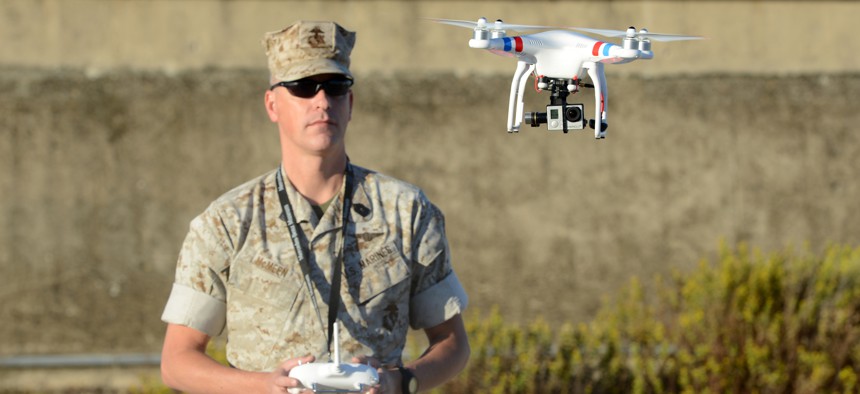
A U.S. Marine uses a commercial-grade Quadcopter to capture aerial video footage of the USNS William R. Button on the pier in Rota, Spain, during the preparation phase of Trident Juncture 2015. U.S. Army photo by Jason Johnston
UK Is Crowdsourcing Its Swarming Drone Attacks
It’s looking for ways to allow a single soldier to control up to 20 drones at once.
What’s that buzzing sound?
The UK’s ministry of defense is hosting a competition to find ways of using smaller drones, rather than the massive things used for bombing and surveillance, on the battlefield. It’s asking British companies to propose a system that would allow a single solider to control up to 20 drones at once, allowing a group of drones to track targets, map out unfamiliar areas for soldiers, run surveillance missions, or provide communications links between soldiers and their central command.
The ministry outlined a list of demands: The system should work for drones of different sizes, be relatively affordable to execute (less than £100,000, or $130,000), and involve novel ways for drones to work together. According to the competition website , the ministry is looking for innovations in drone technologies, including the ability for drones to fly themselves, sense and avoid objects as they fly, work together to navigate better. They also are seeking cheaper power sources, new ways of having multiple robots talk to each other, and secure ways of storing the data the drones transmit.
The ministry is looking for submissions by Nov. 3, with an ultimate delivery goal of October 2018. There will be a group of proposals accepted, with the aim that the companies chosen would theoretically work together for a solution.
The US is working on similar concepts. Earlier this year, the Pentagon announced that it had chosen four companies to attempt to develop small drones that can be dropped like bombs from planes, carry out a mission, and then be scooped back up by another plane. The US Navy has similar technology in the works, building drones that can be deployed from missile launchers:
The UK’s military has also recently started using a tiny surveillance drone that fits in the palm of your hand called the Black Hornet Nano, that can be used for stealthy reconnaissance missions.
Pair these up with the sorts of technologies that the military want to develop through this proposal, and perhaps it won’t be long before we’re seeing real-life technology like this on the battlefield:
NEXT STORY: GM Has Built A Stealth Truck for the Army